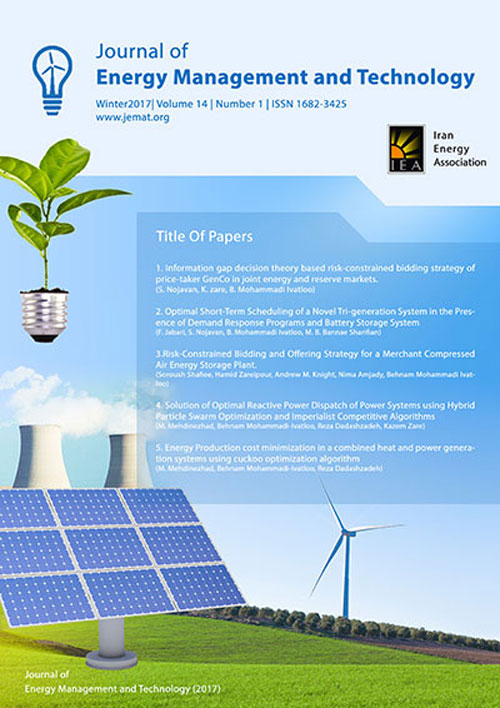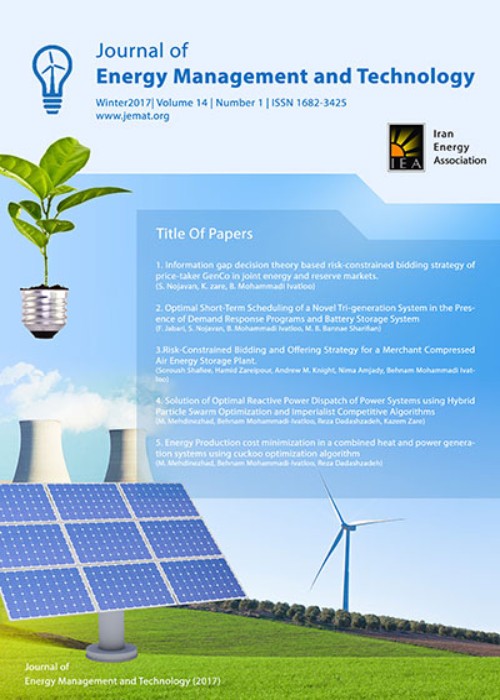فهرست مطالب

Journal of Energy Management and Technology
Volume:6 Issue: 3, Summer 2022
- تاریخ انتشار: 1401/02/12
- تعداد عناوین: 7
-
-
Pages 127-135Recently, seawater desalination is known as a way to face water distribution network challenges related to increasing water demand. A seawater desalination process generally requires a significant amount of heat generated by an electrical energy source. Therefore, the combined water and power (CWP) generating units are applied to reduce the electrical consumption of seawater desalination processes. In the CWP units, the heat energy required for seawater desalination is supplied by using the waste heat of the flue gases exhausted from the power generation part. Therefore, it is highlighted that the freshwater of the CWP unit is dependent on the amount of electrical power generated by this unit. The CWP power generation is usually related to the electrical price in separated electrical and water distribution networks. However, this value can be scheduled based on the value of water demand and electrical price in an integrated electrical-water distribution network. In this paper, a hybrid scheduling model based on stochastic/robust is proposed to minimize the operation cost of an integrated water-electrical system by considering the uncertainty of electricity price and technical constraints of electrical and water distribution systems. The proposed hybrid scheduling model is solved based on the price information obtained by executing an interval forecasting model. In other words, the upper and lower bound of price is forecasted in an interval forecasting model. Then, such parameters are used to find the worst of integrated electrical-water distribution systems against the electrical price uncertainty.Keywords: Integrated electrical, water networks, combined water, power generating unit, robust, stochastic scheduling
-
Pages 136-144The accuracy of the load-frequency control (LFC) system depends on the accuracy of models used for the components that affect the frequency response. In the conventional LFC system, the frequency-sensitive loads, including induction motors, are simply modeled by the load-damping coefficient. The purpose of this paper is to obtain the fifth-, third- and first-order induction motors models for applying in the LFC system. Also, in this paper, the performance and accuracy of these models on the frequency response in a small-scale stand-alone microgrid are compared. In addition, the effect of system and motor parameters on the frequency response characteristics are investigated. The simulation results point out that the commonly used constant load-damping coefficient model can't always appropriately reflect the impact of the induction motors on the frequency response.Keywords: Load-frequency control system, Induction motor, Frequency Response
-
Pages 145-157In this paper, the Combined Heat and Power (CHP) generation concerning distribution networks is investigated. Using the distributed generation based on CHP generation is an important breakthrough in dividing distribution networks into microgrids as the building blocks of smart systems. Therefore, it is necessary to study and evaluate the distributed generation performance together with the CHP generation in microgrids and their operations considering electric and thermal energy storage. In this study, considering the CHP generation units with thermal energy storages, the behavior of a CHP unit is provided and the problem of optimal multi-objective operation of the microgrid is formulated using the evolutionary firefly algorithm (FA). Objective functions of interest consist of microgrid operating costs, grid losses, and voltage deviation of buses from the nominal value. To solve the optimization problem, the evolutionary firefly algorithm is used due to its robustness and effectiveness in this area. The study network has 69 busbars, including several distributed generation units, as well as the CHP generation resources. The obtained results show the effectiveness of multi-objective operation planning of microgrids using thermal loads. By achieving the optimal daily curve of active and thermal power of distributed generation and storage, the proposed scheme can improve economic and operation situation of the network simultaneously; in other words, it can minimize the operating cost of the microgrid, energy loss, and voltage deviations functions simultaneously.Keywords: : Combined heat, power (CHP), heat storage, Multi-purpose operation planning, Firefly algorithm (FA)
-
Pages 158-165In traditional networks, power transmission from production centers to consumption centers causes many issues such as energy losses, decreased reliability, and low power quality. These issues have given rise to a new trend in electricity networks known as microgrids. This paper presents a new hybrid two-stage operational model based on the information gap decision theory (IGDT)/stochastic method for optimum energy management of an islanded microgrid under uncertainties. The suggested model investigates the uncertainty associated with wind energy using the IGDT method without using a probability distribution function or scenario creation. Uncertainties in electricity demand and vehicle owners behavior are also examined using a two-stage stochastic method. The suggested hybrid method, which is described as a bi-level two-stage optimization framework, benefits from both IGDT and scenario-based stochastic programming methods. Furthermore, the proposed microgrid includes new energy sources such as intelligent electric vehicle parking lots, energy storage devices, and demand response programs, all of which work together to decrease the cost of daily operation. According to numerical findings, the optimum utilization of new energy sources under the suggested hybrid approach lowers operational costs by 4.8%.Keywords: Islanded Microgrid, Hybrid optimization, Risk-based model, electric vehicles, demand response
-
Pages 166-175This paper offers a new auxiliary damping control approach based on the wide area measurement system (WAMS) totally to depress sub-synchronous resonance (SSR) in doubly-fed induction generator (DFIG), which is primarily based on wind farms linked to series capacitive compensated transmission networks. In addition, wide area measurement systems have caused their use in power systems with the advancement of technology. However, the delay in sending measurement signals is considered as an important point in spite of all of its benefits if this latency could go to pot the damping overall performance of control approach. This paper presents a fuzzy approach damping controller (FLWADC) to mitigate SSR for the time delay. The FLWADC is a supplementary signal at the stator voltage of the gird-side converter (GSC) of DFIG- based wind farms FLWADC executed by using voltage and the present day of compensating series capacitive because of its established robustness against input sign versions inside the proposed manipulated approach. The effectiveness and validity of the proposed additional damping control were verified on a modified version of the IEEE first benchmark model via time simulation analysis by using Matlab/Simulink.Keywords: DFIG, Fuzzy controller, Wide Area Measurement Systems, Latency, Sub synchronous resonance
-
Pages 176-187The impact of the COVID-19 pandemic on power demand has been studied in some countries. In this study, we investigate the effects of the COVID-19 pandemic on power demand in Tehran, Iran. Hence, power demand variations between 2016 and 2020 are investigated in this research. Results indicate that the effects of the COVID-19 pandemic on power demand vary from month to month and day to day, depending on various factors such as government limitations and the COVID-19 mortality. It is observed that power demand annual growth is changed during both the COVID-19 pandemic and financial crisis. For instance, the average power demand growth in 2020 is 1.03%, while was 4.96% in 2019. Also, most power demand forecasting algorithms have been developed for the normal situation; therefore, we introduce two forecasting algorithms to forecast power demand. The first algorithm is developed based on the principal component regression (PCR), and the second is developed based on the twin support vector machine and quantile regression (TWSVQR). The PCR is selected due to its simplicity and high performance. The proposed PCR model considers daily, annual, and biennial power demand variation rates. The advantage of the TWSVQR method is that it is so accurate, requires a small training dataset, considers various factors for forecasting power demand, and is robust against outlier data. Finally, we investigate our proposed algorithms to forecast power demand in Tehran. Results illustrate proposed algorithms can predict power demandKeywords: COVID-19 pandemic, Power demand forecasting, principal component regression, twin support vector machine, quantile regression
-
Pages 188-208A performance analysis of an operating slaughterhouse was carried out with the objective of identifying challenges, opportunities and improvement measures through operation and proposal of an optimum design of the biogas plant. The facility slaughters an average of 200 cows and 400 sheep per day producing an average of 16,000 kg of solid waste and 40 m3 of wastewater. The study showed that out of the total solid and liquid waste of about 56,000 kg from the slaughterhouse, only 2,800 kg is utilized in biogas production leaving out 53,200 kg of waste untreated by the biogas digestor. This research proposes the construction of an 80 m3 capacity hydrolysis tank, 1,600 m3 capacity digester tank and a 2,000 m3 biogas storage bag for the increased biogas production. Retention time would have to be increased to 20 days from 17 days and substrate PH level increased to 7.0 from average of 6.5. The proposed design will increase biogas production from current 35 m3 to 1,920 m3 and increase solid wasted utilization increase from 1.875% to 75% and that of liquid waste from 6.25% to 100%. Production of biogas and electricity will contribute to greenhouse gas emissions mitigation as one of the wastes to energy pathways in the energy transition. The study concludes that slaughterhouse waste to energy conversion has an important role to play in the sustainable energy transition and a cleaner environment.Keywords: anaerobic digestion, abattoir waste, digester design, Biogas production, optimum conditions for digestion, waste to energy


